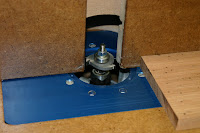 Here is the top in the clamps. I notched out the side pieces around the tube to allow access to the nut when the top is in the cart.
Here is the top in the clamps. I notched out the side pieces around the tube to allow access to the nut when the top is in the cart. After the glue cured, I sanded the top down to 220 grit. I then installed the hardware as shown in the photo. The piece of 3/4" tube is being used to prevent the threaded rod from digging into the wood. I made it about 5/8" long so that it won't interfere with the tightening of the nuts to the side panels.
After the glue cured, I sanded the top down to 220 grit. I then installed the hardware as shown in the photo. The piece of 3/4" tube is being used to prevent the threaded rod from digging into the wood. I made it about 5/8" long so that it won't interfere with the tightening of the nuts to the side panels. Now is the time to cut the notches in the side panels to accept the flip-top. This starts with 7/8" dia. hole centered in the side panel and down about 1".
Now is the time to cut the notches in the side panels to accept the flip-top. This starts with 7/8" dia. hole centered in the side panel and down about 1". I extend a couple of tangent lines from the hole and then cut the sides of the notch.
I extend a couple of tangent lines from the hole and then cut the sides of the notch. Oops! When I said the holes are to be centered, I meant they were to be centered in the side panels. I'm not exactly sure what I centered this hole on, but it clearly wasn't the side panel. So now we get to work on our repair skills.
Oops! When I said the holes are to be centered, I meant they were to be centered in the side panels. I'm not exactly sure what I centered this hole on, but it clearly wasn't the side panel. So now we get to work on our repair skills. This is what I came up with. It's a piece of the red oak I cut from scrap that closely matched the grain around the boo-boo. I roughly cut it out on the bandsaw and final shaped it on the spindle sander until it fit snugly.
This is what I came up with. It's a piece of the red oak I cut from scrap that closely matched the grain around the boo-boo. I roughly cut it out on the bandsaw and final shaped it on the spindle sander until it fit snugly. A bit of glue and a clamp to align the faces and I ended-up with this. A little more sanding to blend and we'll pretend it never happened.
A bit of glue and a clamp to align the faces and I ended-up with this. A little more sanding to blend and we'll pretend it never happened. Now that the side-show is over, we can continue with the assembly of the cart. This is a picture of the cart with all the woodworking complete. I added the barrel-bolts to lock the table in place.
Now that the side-show is over, we can continue with the assembly of the cart. This is a picture of the cart with all the woodworking complete. I added the barrel-bolts to lock the table in place.That completes the woodworking for the cart. I'll add a finish as soon as I can make up my mind what to use (danish oil...poly....danish oil...poly....). Once that is done, I'll add the planer. This will be attached with 3/8" dia x 3-1/2" long carriage bolts. I will probably go ahead and attach the planer for a trial run before I apply the finish, now that I think about it. When I get the planer attached and the finish applied, I'll post final pictures (along with the plans).



 This is how the tube fits into the channel. The tube sticks out about 5/16" on each side. The shallow dado cut in the outer plys was useful for positioning the tube perpendicular to the sides.
This is how the tube fits into the channel. The tube sticks out about 5/16" on each side. The shallow dado cut in the outer plys was useful for positioning the tube perpendicular to the sides.













